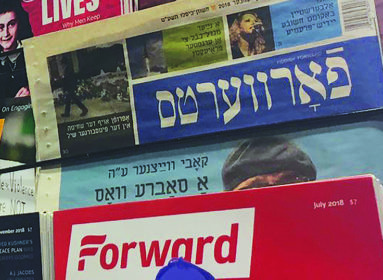
By Cindy Mindell
By some accounts, Jews began arriving in India as King Solomon’s merchants, seeking materials to construct his first temple in Jerusalem. South Indian Christian legends confirm that Jews settled in Cochin during the first century C.E., after the destruction of the Second Temple.
Other communities formed over the next several centuries: the Bene Israel – thought to be a Lost Tribe – came to western India some 1,000 years ago. Spanish and Portuguese Jews came to Madras and Goa in the 17th century. In the early 18th century, Baghdadi Jews migrated to western India and then Mumbai (previously called Bombay) and Calcutta from Iraq, Iran, Afghanistan, and Arab countries. Later arrivals and converts are scattered throughout the country, including Delhi.
While there is still a small Jewish presence in India, most of the 30,000 Jews left the country for the English-speaking world in 1947, when India gained independence from Great Britain; or they made aliyah starting the following year, with the establishment of the State of Israel.
Today in India, Jews practice their religion openly in the larger communities of Mumbai and Thane, and in smaller communities in cities including Pune, Gujarat (Ahmedabad), Cochin, Delhi, Calcutta, and the Konkan Villages. This, according to the American Jewish Joint Distribution Committee (JDC), which has provided social services to poor, elderly, and vulnerable Jews in India since 1964. The JDC runs a Jewish community center in Mumbai with classes in Hebrew and Jewish topics, holiday celebrations, and social programming for youth and adults.
World ORT, the Jewish educational and vocational training non-profit organization, serves the Jewish communities of Mumbai and the surrounding region, with a wide range of vocational training, and a pre-school that also trains future childcare workers, as well as the country’s only kosher bakery. ORT India provides vocational training and aliyah preparation for members of the remote Bnei Menashe community in Mizoram and Manipur to the northeast, and set up a computer center in Manipur. The organization has also worked with Taglit-Birthright to send young Indian Jews on trips to Israel.
Twenty miles northeast of Mumbai is Thane, where Jews settled in the 16th century and now home to some 1,500 Jews and the Shaar Hashamaim synagogue, mikveh, and community center.
Chabad-Lubavitch runs four houses throughout the country, including in Mumbai, where in November 2008 Islamic terrorists murdered Rabbi Gabi and Rivky Holzberg and four guests.
The Indian Jewish émigrés have worked to keep their ancient culture and traditions alive at home and at cultural centers and synagogues, mostly in Israel, which boasts an Indian-Jewish community of at least 70,000.
But Indian Jewish immigrants also exported non-Jewish rituals as well. While in India, the Jews of Cochin adopted Onam, the ancient harvest festival of their Hindu neighbors, welcoming the legendary King Mahabali on his annual return to the Kerala region. Over 10 days, revelers prepare an elaborate vegetarian feast and create flower “carpets” at the entrance of their homes, engaging in special games, a boat race, and a traditional dance.
Ten years ago, Onam went public in Israel. Celebrated nostalgically behind the closed doors of some Cochini olim since the ‘50s, the first community Onam was organized in 2004 by a small group of Indian Jews in Hadera. By 2011, the celebration had grown so large that the Central Bus Terminal in Tel Aviv was required to accommodate the 2,000 participants – including non-Jewish Kerala citizens living and working in Israel on work permits.
The Cochin Jewish Heritage Center on Moshav Nevatim near Be’er Sheva has become a tourist destination featuring a Cochini restaurant and guest house.
In 2013 and 2014, thousands of Indian Jews and their descendants gathered for the annual National Convention of Indian Jews in Israel.
Outside of Israel, Indian-Jewish communities are less organized. There are several synagogues and associations in England and Australia. In the U.S., a group of Bene Israel Jews in New York meets for holidays, and Los Angeles is home to the Kahal Joseph Congregation, founded by Baghdadi Jews.
Then there’s Calcutta native Rahel Musleah, a seventh-generation Jew born to a Calcutta family that traces its roots to 17th-century Baghdad. A U.S. resident since age six, Musleah has dedicated her professional life to bringing and keeping Indian Jewish tradition alive. As a singer, storyteller, acclaimed author, and award-winning journalist, she shares her rare and intimate knowledge of this ancient community through multi-media presentations and tours to Jewish India.
Musleah will present “Jewish Calcutta through Music and Memory” on Thursday, June 4 at The Emanuel Synagogue in West Hartford. Sponsored by the Jewish Historical Society of Greater Hartford, the program is a collage of lyrical songs and distinctive customs of her community, complemented by personal anecdotes, memorabilia, and authentic photographs.
Musleah’s father, Ezekiel Musleah, came to the U.S. to study at the Jewish Theological Seminary in New York from 1947 to 1952, when he was ordained. He had been influenced in his career choice by David Seligson, a Jewish chaplain stationed in India during World War II. The new rabbi returned to serve the Calcutta Jewish community for 12 years, during which time he married and started a family that would grow to include three daughters. In 1964, he was offered a job at Congregation Mikveh Israel, the Spanish and Portuguese synagogue in Philadelphia, and brought the family to the U.S.
“Our home was like a little Indian Jewish oasis in Philadelphia,” Rahel Musleah recalls. “Since I was young when we left Calcutta, I grew up mostly surrounded by the Spanish and Portuguese melodies and nusach, but at home, we learned all the tropes and songs for Shabbat and chagim (holidays) from my father.”
Musleah graduated from Columbia University and the Jewish Theological Seminary and studied more seriously with her father so that she could lead services and go deeper into the family’s tradition. In addition to writing about Indian Jewish culture (and other aspects of Jewish life) for national publications including the New York Times, Hadassah Magazine, Reform Judaism and Jewish Woman, she began to share her first-hand knowledge as a scholar-in-residence and as a tour guide to Jewish India.
The story of that community traces the universal arc of so many communities that were once vibrant and flourishing, and then dwindle and relocate. “There are these beautiful edifices in Calcutta and Cochin with few people to pray in them or bring them alive,” Musleah says. “The Bene Israel still have a thriving presence in Bombay [Mumbai], but even there, the size of the community has diminished considerably.”
In addition to the community centers and synagogues established to preserve traditions, Indian Jews and their descendants do so by writing memoirs and cookbooks, creating digitized archives, and, like Ezekiel Musleah, recording religious songs and services.
“That’s part of why I do what I do: to increase awareness that there was a vibrant community in India, and that it still exists in some places,” says Musleah. “When I take my groups to India, we visit many synagogues that we bring alive with music. We meet, interact, and share meals with members of the communities. For me, it’s very fulfilling to be able to physically bring people to these beautiful places, to show them the beauty first-hand, and to fill the awesome spaces with song. To lead services and stand on the tebah – the bimah – where my father, grandfather, and great-grandfather stood is truly an indescribable experience. Somebody asked me, ‘What would your ancestors think of a woman leading a service in what was an Orthodox synagogue?’ I have to think that they would feel joy that I am attempting to pass on and demonstrate our traditions, that I am trying to bring their beauty alive.”
Jewish Calcutta through Music and Memory with Rahel Musleah: Thursday, June 4, 6 PM, The Emanuel Synagogue, 160 Mohegan Drive, West Hartford. For information and/or tickets, contact the Jewish Historical Society of Greater Hartford at jhsgh.org or (860) 727-6170.
Shavuot on the Table
A Recipe from an Indian-Jewish Kitchen
Rahel Musleah offered these recipes that highlight the unique flavors of Indian-Jewish cuisine. The first – Cheese Samboosaks – is perfect for the upcoming Shavuot holiday.
Cheese Samboosaks
Dough:
1 cup self-rising flour
3 cups plain flour
½ cup oil
1 cup tepid water (approx.)
Filling:
½ lb. mozzarella, ½ lb. cheddar, grated
1 tablespoon plain flour
5 eggs (about), beaten
Pinch of cayenne pepper
Mix flour and oil in bowl. Add ¾ cup of the water, and add the last quarter-cup gradually until it becomes a soft dough. If after one cup the dough is still stiff, add an additional teaspoon of water at a time. You do not have to knead it like bread. When you think you are done, pinch a piece off and roll it into a ball in the palm of your hands. Cover the bowl with wax paper or towel so the dough doesn’t dry out.
Put the grated cheese in another bowl, and gradually add the beaten eggs, stirring until the mixture is moist enough to hold. Add the tbsp. of flour and mix together. The mixture must not be too stiff or too liquid. If it is stiff, add one or two more eggs.
Shape the dough into small balls. Place the balls one at a time on a floured board and roll to a small, thin circle with a rolling pin. Place one heaped teaspoon of the cheese mixture on one half of the circle, fold over the other half and press the edges firmly together. Cut around the edges with a dough cutter or sharp knife. Discard or reuse the dough that is cut away.
Place samboosaks on a greased baking sheet and bake in 375-degree oven for 18 minutes.
Makes about 36.
Bhajee Vegetable Curry
2 tablespoons mild curry paste (I use Patak’s)
2 tablespoons tomato paste
1 tablespoons panch puran spice (5 spice mix, available in Indian shops, optional)
4 tablespoons fresh cilantro, chopped
½ c. water
3 medium potatoes, peeled and cubed
1 cauliflower, broken into flowerettes
3 carrots, peeled and sliced
½ lb frozen peas (You can substitute almost any vegetables for these)
Put curry paste, tomato paste and 2 tablespoons cilantro in large non-stick pot on medium-low flame. Add potatoes and ½ cup water. Cook 10 minutes, covered, stirring occasionally. Add cauliflower and carrots and cook about another 20 minutes, until vegetables can be pierced with a fork. Add peas and cook another 10 minutes until tender. Garnish with cilantro and serve with rice pilau.
 Kishmish Badam (Raisins and Almonds)
Kishmish Badam (Raisins and Almonds)
¼ cup slivered almonds
¼ cup raisins
2 tablespoons oil
In small saucepan, heat 1 tablespoon oil on low-medium heat until warm. Add slivered almonds and saute, stirring continually, until golden. Remove and drain on paper towels. Add 1 tablespoon oil to same pan, saute raisins until they plump up. Remove from oil and drain on paper towel (they will shrivel back up). Mix raisins (kishmish) and almonds (badam) and sprinkle on rice before serving.








 Southern New England Jewish Ledger
Southern New England Jewish Ledger












